■ Mohammad Al-Hakimi
By the advent of the 19th century, and for multiple reasons, Yemen lost its control on coffee export, from its clay ports to the countries worldwide; nevertheless, the Yemeni coffee trade -at that time- did not disappear or decline.
Based on documents from the American National Archive, one of the studies, (Holm Akhdar obtained copy of it), documents an important aspect of the untold story about the Yemeni coffee trade and export during the first half of the 20th century.
This article, traces the story of the international competition to dominate Yemeni coffee in the 20th century, and how American, Italian and French merchants sought to control the export of Yemeni coffee, which is considered the finest in the world.

The History of Coffee: From Mocha to all over the World
For decades, the coffee tree was associated with Yemen, constituting the main national source of wealth for the country, and gaining a worldwide fame for its quality and taste.
Since the end of the 14th century, Yemen has monopolized the secrets of coffee cultivation, and coffee was exported to world markets from the port of Mocha, west of Yemen, from which the name “Mocha” was derived.
In the 9th century AH, said one of the sources, the first reliable evidence of drinking coffee and the knowledge about the coffee tree emerged inside the Sufi monasteries in Yemen, where coffee beans were roasted, fermented, and ground for the first time.
As mentioned in the manuscript (below), “coffee was first discovered and introduced to Aden was the Sufi scholar Jamaladdin Abi Abdullah Mohammad bin Saeed Al-Dhubhani,” whose lineage goes back to “Dhubhan’ a well-known town in Yemen. (1)
Throughout the era of the first Ottoman Rule in Yemen (1536 -1636), Yemen used to have a global monopoly on the coffee trade, and the Turks controlled coffee export through the ports of Yemen.
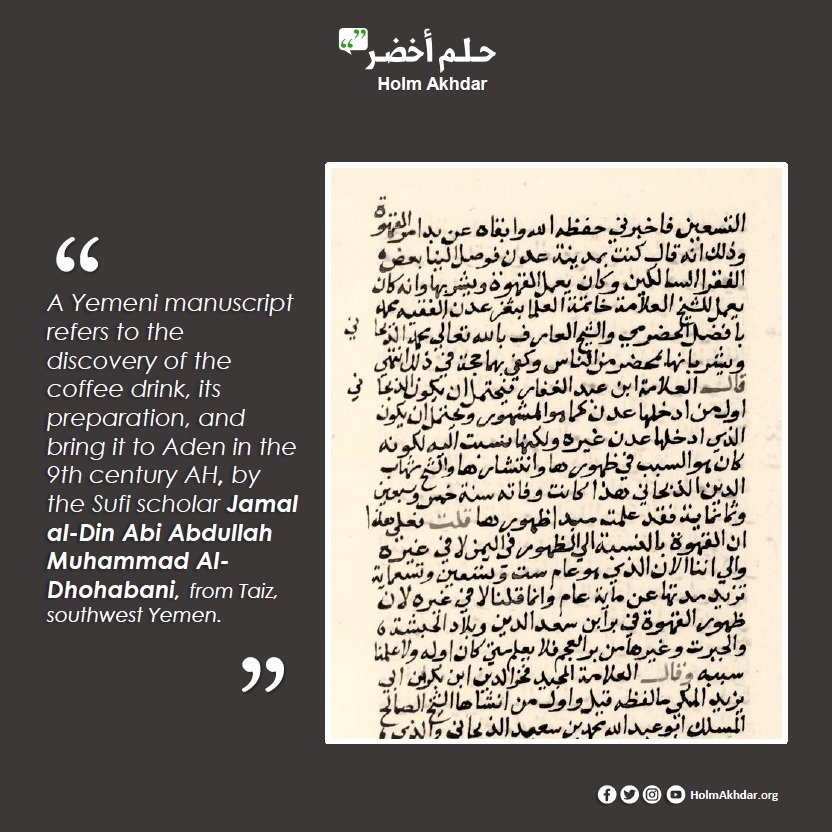
Two coffee factories in Mocha
The first shipment of Yemeni coffee (Mocha Coffee), as mentioned in a research article, was purchased by the Dutch from the port of Mocha in 1628.
Later in the period of 1750s, there appeared a growing demand and a fierce competition for Yemeni coffee between French, British and Dutch companies.
The highest production of Yemeni Arab Coffee (Coffee Arabica) was in 1720. Earlier in 1708, the Dutch established a factory for coffee in Mocha area and began to export it.
A year later (in 1709), the French established another coffee factory in the same region. As a result, the ports of Mocha, Al Hodeidah, and Al Luḩayyah witnessed a great movement of coffee trade. (2)
However, with the Yemeni coffee gaining worldwide popularity, the port of Mocha had an increasingly strong monopoly on coffee export, compared to other ports of Yemen, as it was the only port in the world exporting Yemeni coffee until the end of the 18th century.

Yemeni Coffee in the 19th Century
A historical study on “Yemeni-American relations 1904-1948” by the researcher Mahmoud Hamlan reveals that, at the beginning of the 19th century, about three-quarters of the Yemeni coffee production had been transported from the port of Mocha by American trade ships before the establishment of any mutual diplomatic or commercial relations between the two countries. (3)
In 1809, and due to the American competition at the time, the prices of the Yemeni coffee (prevailing at the East India Company (EIC) rocketed from 56$ (about 12 Sterling Pound) for a big fabric sack to 70 $ (15 Sterling Pounds). (4)
Moreover, New England merchants developed the trade route through the Red Sea along the east coast of Africa, instead of turning around Cape of Good Hope. This step saved them the freight charges that were added to the commercial costs imposed by the East India Company.
During the period (from June 1812 until February 1815), the Yemeni coffee trade dwindled and coffee exports plummeted to the lowest levels, due to the United States declaring war on Britain.
The United States’ declaration of war against Britain (War of 1812) was a result of the latter’s interception of the trade ships.
Two years and 8 months later, the Yemeni coffee export trade had gradually begun to boost, and was organized intermittently.
The study “Yemeni-American Relations” provided numerous data documenting the history of the Yemeni coffee export, based on the document Archive of the American Consulate in Aden issued at the beginning of the 20th century.
The study also confirms that the American – British partnership in the trade and export of Mocha coffee through the port of Mocha had been active for more than 40 years (1797 – 1839).
Whereas the amount of coffee exported from Yemen to the world at the beginning of the 18th century, as indicated in a research article, reached about 20 thousand tons per year.
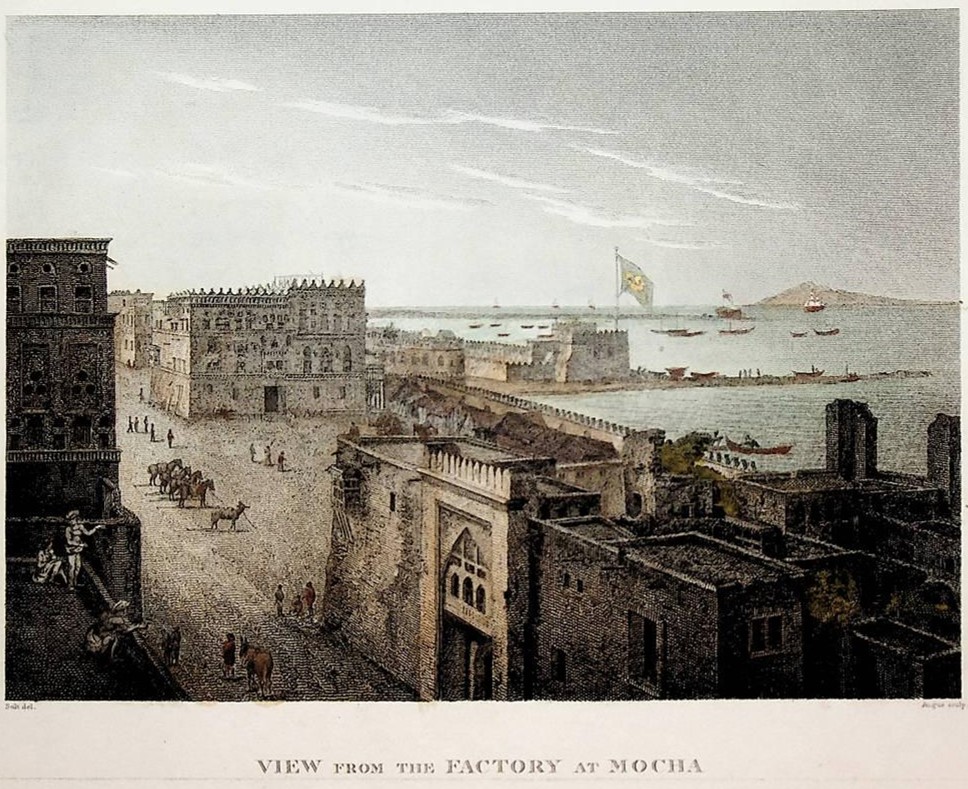
In 1832, Yemeni coffee, leaves of Senna (CASSIA ALAT), leather, and frankincense were the main goods that American merchants used to buy from the port of Mocha. In return, these merchants dispose of American cotton merchandises by selling them to Mocha merchants with little profits. As recorded in the voyage diaries of Joseph Barlow Welt to the ports of Aden and Mocha in mid of the 19th century.
In his book “Travel Notes”, the traveler Joseph Welt says, “The German Crown Currency was considered the main currency in Mocha as it was free of defects, and it was as valuable as the Spanish dollar that was used without objections. However, the US dollar was not in circulation at that time. Besides, merchants in Mocha were not given any credit, nor did they receive any interests on loans”.
Furthermore, an article states that the “Yemeni Coffee had become very popular in Europe, especially France, and it was widely known that the best coffee came from Yemen, a fact not lost on Lyon businessmen Alfred & Pierre Bardey. By 1880 around half the Yemen export coffee crop was sent to France, which had become much easier following the opening of the Suez Canal in 1869”.

Competition for Coffee Trade Control
By the beginning of the 20th century, American merchants took control over the trade of the Yemeni coffee, although half of this trade was dominated by Sultan Mohammad Ali Basha (Egypt governor). Yet, Mocha coffee was sold to the Americans at high prices. (Hamlan, 2008).
In 1933, according to American documents, the shipments of Yemeni coffee exported through the port of Hodeidah to foreign countries were very good due to the emergent of the free trade.
In the same year, commercial quantities of Yemeni coffee were exported, before the “Yemeni Import and Export Company” begin to operate – a company established (in 1934) by the government of Imam Yahya Hamid ed-Din to dominate the coffee trade. (5)
According to the American documents, “The total quantity of Yemeni coffee that was exported from Yemen during a 6-month period (from January to June in 1933) amounted to about 27,918 thousand sacks. Each sack contains 80 kilograms of coffee. That is equivalent to about 2,233,440 million kilograms of coffee.
And these exported quantities of Yemeni coffee were imported by a number of countries, most notably: Italy, France, the U.S, Britain, and others”.
Importing coffee from Yemen, Italy ranked first, given that it had signed a trade cooperation agreement with Yemen and obtained concessions in the coffee trade.
In 1933, the quantities of Yemeni coffee imported by Italy reached about 11,478 sacks of coffee, with 80 kilograms of coffee in each sack.
In the same year, France came second as its imported quantity of Yemeni coffee reached about 8,040 sacks of coffee (each sack 80 kg).
The United States of America ranked third in the list of Yemeni coffee importers in 1933, as the quantities of coffee exported to the U.S stood at about 6,550 sacks of coffee (each sack 80 kg).
Whereas Britain got the eighth rank by importing about 1,850 sacks of the Yemeni coffee.

Coffee Farmers Being Exploited
In her book “A French doctor in the Yemen”, the French researcher and physician Claudie Fayein (1921-2002), who stayed in Yemen in the early 1950s, provided some details about the trade of Yemeni coffee, explaining how small coffee farmers were being exploited by big merchants (wholesalers) and foreign exporters.
As they used to buy the coffee crop from the farmers at a low price, and sell it for five times the amount they paid to those farmers.
“As a guest in his house, one of the Yemeni princes offered me a mug of coffee in his comfortable Mafraj, (a room with a beautiful view), and we talked about the cultivation of coffee, which – along with the leather trade – constituted the main wealth of Yemen,” says Fayein. The prince explained to me the method of growing coffee trees and the secret of coffee.”.
“The coffee farmlands (inherited and owned by Small farmers) have been prepared since ancient times, on the flat-topped hills, and the agricultural terraces on high mountains. Small farmers sell the coffee crop to wholesalers who, in turns, sell it to exporters in the port of Hodeidah. Then coffee is transported over camels, and that one camel carries two big saddlebags, each one contains 90 kilograms of coffee. The price of each big saddle bag (Zakibah) is about 100 Riyals.” Said the prince.
“And when I asked the prince, for how much does the merchant buy the coffee harvest from the farmers, he told me: The wholesaler buys the coffee harvest from the farmer at 20 riyals for one each saddlebag.” (Al-Zakiba: a large sack of burlap)
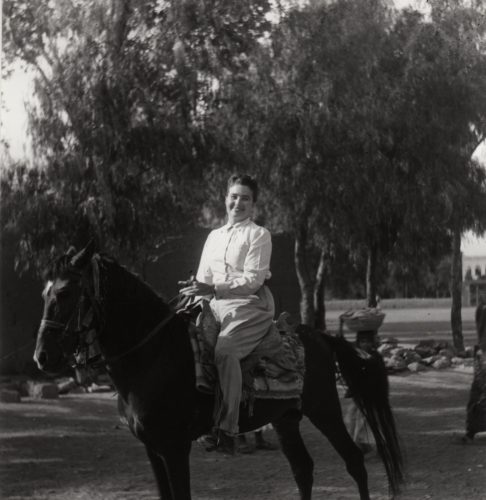
“But as I asked him, Claudie says, why doesn’t the farmer personally go to Hodeidah and directly sell his coffee harvest there?” “The farmer cannot go!”, replied the prince, because, every year, wholesalers pay for the coffee harvest in advance, so that there is nothing left for the farmer upon delivery but an amount of ten riyals for each big saddlebag.”.
Carrying on the conversation, I asked the prince, why do farmers get such loans? Even though I knew that usury is also prevalent here as just as it is in the Eastern countries, the prince was cautious, so once we reached this point, he madly got up of his place, his smile vanished, and he rudely ended our conversation! ” (Fayein, 1960).
Antonin Besse: A French Merchant
In the same context, in her book, the French researcher Claudie Fayein, referred to the famous French merchant Monsieur Antonin Besse, who resided in Aden for about 50 years and built a huge commercial empire there, after he dominated the trade and export of Yemeni coffee, in addition to the leather trade, and other businesses. As he was nicknamed as “The King of the Red Sea.”
On April 16, 1899, Antonin Besse came from Marseille on a ship to Aden to work for the agency of the French merchant Pierre Bardey, who was a founding partner of “Bardey & Co”, one of the agencies working in the export of coffee brought from the north of Yemen to Aden Protectorate– a British Colony then.
In 1902, Antonin established a small agency in Hodeidah to buy the coffee harvest. And within 10 years, Antonin Besse’s influence extended inside and outside Yemen, benefitting from the fact that the port of Al Hodeidah was not developed and unsuitable for receiving large or medium-sized trade ships, as a result, the Yemeni coffee export was mostly carried out through the port of Aden.
About her meeting with Antonin, Fayein says: “He kept repeating the same words he had already said to the doctors of the First French Mission that visited him 3 years ago: that the Yemenis are only a pack of thieves and bandits, and I will throw myself between the jaws of wolves. Yet, he reassuringly promised that he will come to my aid and will never let me alone.”.
“I thanked him; but I got more determined to visit Yemen and see those “thieves” who turned out to be farmers dared to refuse to give their coffee harvest to Monsieur Antonin Besse.” Fayein added. (6)
Marcel Wagner: An American Merchant
Among the merchants exporting Yemeni coffee, as mentioned in the documents of Aden Consulate, the American businessman Marcel E. Wagner, the Head of American Eastern Corporation that worked, within several companies, in the field of shipping, export and ship navigation.
In the 1940s, Wagner had direct commercial relations with the English authorities in Aden, and with a number of princes and officials in the Yemeni regions, and as the sources indicated that Wagoner preferred to offer the trucks or agricultural equipment that he owned, in exchange for shipments of Yemeni coffee, instead of paying in cash.

Coffee Sales in the 20th Century
The book of “Yemeni-American Relations 1904-1948” indicates that the American Consulate in Aden Protectorate took part in monitoring the data of the economic and trade movement in Yemen, and it was able to show the volume and capacity of Yemeni coffee production, as a source of foreign exchange.
Based on the documents of the American National Archives 1940s, the US Consulate estimated that “the annual volume of Yemeni coffee production amounted to more than 539,800 U.S dollars in 1939.”.
And the total domestic production of coffee in Yemen can be entirely exported, as only the coffee husk (Qishr) is preferred and used for local consumption.
Shipments of Yemeni coffee sent overseas were exported through the port of Aden and the port of Jeddah in Saudi Arabia, in addition to other shipments across the Red Sea coast from the port of Hodeidah, or other quantities carried on camel caravans come from the north of Yemen.
As in the American documents, “30% of Yemeni coffee exports went to the United States of America through the ports of Aden and Jeddah.
Whereas other countries such as Norway, Switzerland and France get Yemeni coffee exports at different proportions.”.
The British exporters from the Protectorate of Aden, according to the sources, used to pay for the Yemeni coffee in Austrian Riyal or Maria Theresa thaler, and buy coffee in Sterling Pounds from Yemeni coffee traders.
Meanwhile, Saudi Arabia was suffering from a shortage of dollars, so it was not ready to provide Yemen with any US dollars it could get from exporting Yemeni coffee through the port of Jeddah.

Yemeni Coffee Shipments to USA
The Yemeni coffee exports to the United States were paid for in cash directly to Yemen, using a direct payment system, after being shipped from the port of Hodeidah to New York, due to Hudeidah’s nearness to the coffee-growing areas, and to ensure that the quality of the coffee not to decline due to transportation or time conditions.
One of the telegrams from the US Consulate in Aden says, “The demand in the American market for Yemeni coffee (Mocha) was growing, but not largely, and that the future expansion of coffee trade in the American market is possible depending on the capability of Yemen to increase its coffee exports.”
In 1936 and 1937, most of the Yemeni exports to the United States of America were the exports of Yemeni coffee.
In the following ten years, from 1937 to 1947, coffee of Yemeni origin was being exported to the United States of America through the ports of Aden and Jeddah.
One of the US Consulate reports (at that time) indicated that, “there was a constant increase in the quantities of Yemeni coffee exported through the port of Jeddah, during the period 1936 – 1940. Then there occurred a sharp decline in the quantities of Yemeni coffee exported from the port of Aden and the port of Jeddah during the period 1941 – 1943”.
After that, “Yemeni coffee exports halted during the years 1943-1945, due to the conditions of the World War II that hindered the ships movement and impeded the export and import processes.”.
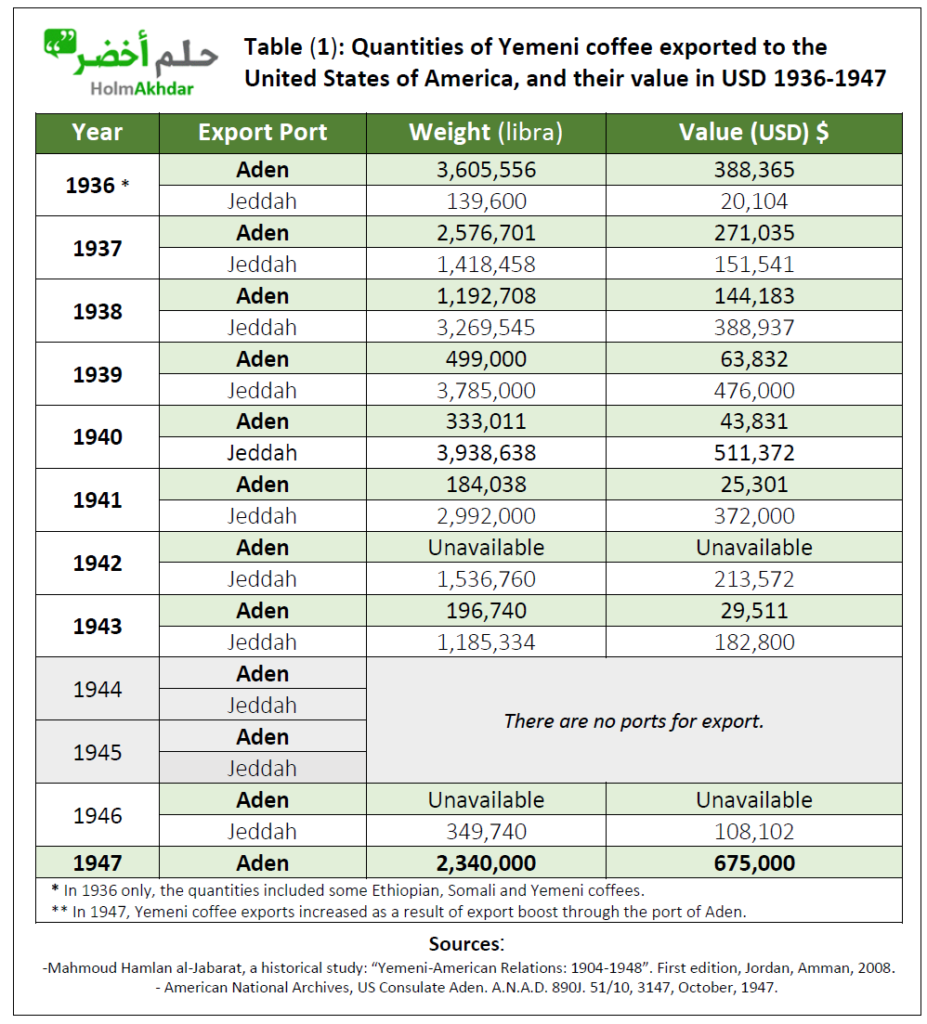
Increased Competition
According to an American document cited in the study (Hamlan, 2008), “Yemen’s coffee exports amounted to about $ 555,203 in 1940.
And in 1947, Yemeni coffee exports increased to about $ 675,000, as a result of export boost through the port of Aden.
Furthermore, the document of the US Consulate in Aden dated October 30, 1947, addressing the US State Department, stated that, “In order for Yemeni coffee to be competitive in the American market, it is required to be directly shipped from the port of Hodeidah to the port of New York, and that the purchase is to be made by direct payment in US dollars by the Yemeni merchants.”.
During that period, American traders sought to dominate the Yemeni coffee export trade, and to compete with the Italian merchants who had a complete monopoly on the Yemeni coffee export trade for many years. (Hamlan, 2008)
And it was evident that the Italo-Yemeni Treaty of 1926 “also known as the Treaty of Sana’a” signed between Yemen and Italy had a competing impact on the Yemeni coffee export to the United States.
In 1945, a trade development took place, as the United States of America expanded its trade with Yemen to become the second largest importer of Yemeni coffee. As stated in the document of the US Consulate in Aden.
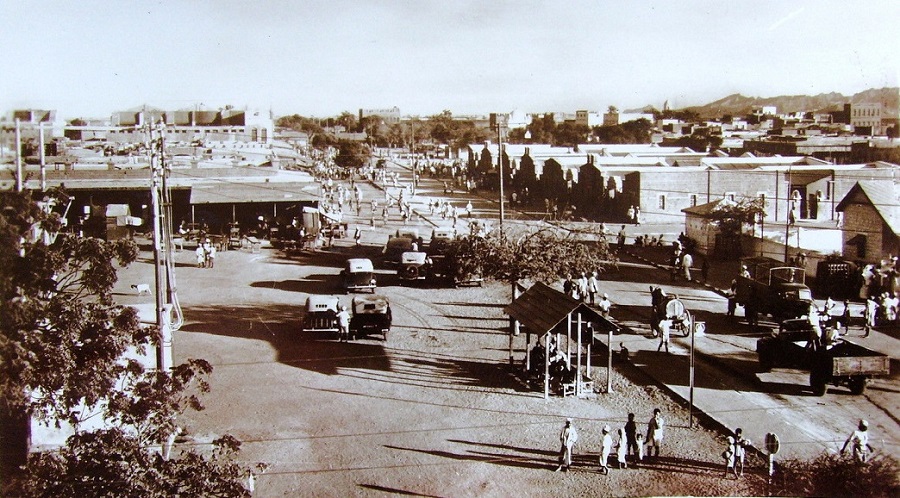
Coffee Export
This had happened as a result of the US State Department mandating the US Consul in Aden Protectorate to visit Yemen and establish mutual diplomatic relations between the two countries, which resulted in the signing of a friendship and trade agreement. (Hamlan)
This agreement had gained acceptance; yet it only fulfilled the desire of the American merchants who, for the sake of their trade in importing the Yemeni coffee, sought for the development of these trade relations more than their Yemeni counterparts did.
In order to benefit the local coffee producers, Yemeni coffee exports (In the mid of 1940s) mainly required the building of a small port connected to the Yemeni regions by a railway or a transportation highway. This port would enable Yemen to export coffee and leather, import goods and capital needs faster and in better returns. (Hamlan, 2008)
In addition to the need for the expansion of the port of Hodeidah, which was disqualified although under Yemen’s control. Also, the port of Mocha became obsolete after being flooded by sand and its facilities were subject to serious destruction.
According to the book “The Formation of Modern Yemen” by the historian Sayid Mustafa Salem, “the neglect and official failure of the Imam’s government was evident during that period. This was clear in his failure to develop ports, support agriculture and grant facilities to small farmers. (7)
However, as indicated in Hamlan’s study “the US government – despite having signed a trade cooperation agreement with the Imam’s government – did not agree to grant Yemen a financial loan to develop and expand the port of Hodeidah.”.

Obstacles and Challenges
In July 1947, the American Consulate in Aden attached, in one of its telegrams, a feasibility study regarding the expansion of the port of Al Hodeidah, entitled: “Yemeni Coffee Production as a Source of Foreign Exchange”. (Hamlan, 2008).
That telegram also mentioned that “the Yemeni production of coffee is estimated at 12,000,000 Sterling Pounds a year, and all coffee production in the country can be exported, because only the coffee husk (Qishr) is preferred and used for domestic consumption”.
One article indicates that by 1955, Yemeni coffee was one of the most valuable re-export commodities in Aden, making more than £ 3,000,000 from foreign currency. And the main buyers of coffee were the United States of America, Italy and Japan.
However, many obstacles impeded the boom of the Yemeni coffee export to the countries around the world, most notably: that the Yemeni coffee export was carried out through ports under the British control, namely: the port of Aden and the port of Jeddah.
At that time, the British policy towards Yemen (north and south) was hostile. Besides, there was no direct and reciprocal trade between the two countries, so mutual trade remained limited.
In addition, British coffee merchants in Aden used to pay for the Yemeni coffee in Austrian Riyal, the currency of Maria Theresa.
In contrast, Yemeni merchants did not have any US dollars to use or buy things with, along with the absence of banks, or a banking and credit market, in Yemen at that time as well as the absence of Yemeni political and economic forces capable of providing facilities in the field of international trade. In addition, the Yemeni ports were ineligible to receive US trade ships with huge tonnages.


Yemeni Coffee Today
Cultivation of Yemeni coffee is down at present, and Mocha coffee is no longer a monopoly on the world market.
As a result of the government neglect, Yemeni coffee farmers have switched from cultivating coffee to qat tree cultivation, and the area of the cultivated coffee has shrunk by two-thirds for the interest of Qat tree cultivation.
The Ministry of Industry and Trade indicates that the Yemeni coffee, until the mid of the 20th century, continued to be grown in agricultural terraces on the mountainous heights.
Sixty years ago, the area cultivated with coffee was more than 110 thousand hectares, and coffee production amounted to about 55 thousand tons. Besides, the quantity of the annually exported Yemeni coffee reached more than 44 thousand tons.
Nowadays, according to Yemeni agriculture statistics of 2019, the coffee cultivation area is estimated at 34 thousand hectares only, and the annual coffee production is about 20 thousand tons.
Whereas, the percentage of Yemeni coffee currently exported does not exceed 0.1%, where the amount of coffee export ranges between 3000-4000 thousand tons annually. Globally, Yemen ranks 42nd out of 64 coffee exporting countries around the world.
Notwithstanding all these heavy losses, Yemen still enjoys one or two advantages, and it has not completely lost its agricultural secrets.
As Yemen’s environment, agricultural soil, and climatic conditions give Yemeni coffee its ancient charm.
Despite all the failure and frustration of Yemeni coffee cultivation, yet the international coffee varieties do not compete with the taste of Yemeni coffee, as the latter is still globally known for its finest quality and taste, and most importantly, it is being sold for the highest price in the world.
List of Sources and References:
(1). Maqshir, Abdul-Wadood, “The story of the discovery and discovery of coffee in Mokha, Yemen”, article series, episode 8, NewsYemen website, August 14, 2019.
(2). Abdo, Bakri, “The Current Status of Coffee Production in the Republic of Yemen”, Arab Scientific Society Organization, ASCO, March 10, 2014.
(3). Mahmoud M. Hamlan, “Yemeni-American Relations: 1904-1948,” Yarmouk University, First Edition, Jordan, Amman, 2008.
(4). American National Archives, US Consulate, Aden. A.N.A.D. 890J. 602/3, August 2, 1932
(5). American National Archives Document, Aden. A.N.A.D. 890J. 51/10, 3147, October 30, 1947.
(6). Claudie Fayein, “A French doctor in the Yemen”, Translated by: Mohsen Al-Aini, Beirut, First Edition, Dar Al-Awda, Lebanon, 1970.
(7). Salem, Syed Mustafa, “The Formation of Modern Yemen, 1- Yemen and Imam Yahya, 1904-1948”, Fourth Edition, Sana’a, Al-Ershad bookshop, Yemen, 2006.
